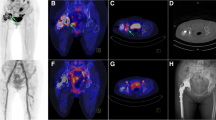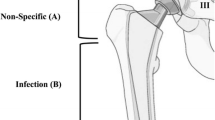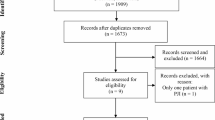Abstract
Purpose
To assess the efficiency of [68 Ga]Ga-DOTA-FAPI-04 in diagnosing periprosthetic hip joint infection and establish a diagnostic standard of clinical significance based on uptake pattern.
Methods
[68 Ga]Ga-DOTA-FAPI-04 PET/CT was performed in patients with symptomatic hip arthroplasty from December 2019 to July 2022. The reference standard was based on the 2018 Evidence-Based and Validation Criteria. Two diagnostic criteria, SUVmax and uptake pattern, were used to diagnose PJI. Meanwhile, original data were imported into IKT-snap to draw the view of interest, A.K. was used to extract features of clinical cases, and unsupervised clustering analysis was applied according to the groups.
Results
A total of 103 patients were included, 28 of whom had PJI. The area under the curve of SUVmax was 0.898, which was better than that of all of the serological tests. The cutoff value of SUVmax was 7.53, and the sensitivity and specificity were 100 and 72%, respectively. The sensitivity, specificity and accuracy of the uptake pattern were 100, 93.1 and 95%, respectively. In radiomics analysis, the features of PJI were significantly different from those of aseptic failure.
Conclusion
The efficiency of [68 Ga]Ga-DOTA-FAPI-04 PET/CT in diagnosing PJI showed promising results, and the diagnostic criteria of the uptake pattern were more clinically instructive. Radiomics also showed certain application prospects in the field of PJI.
Trial registration number
Trial registration: ChiCTR2000041204. Registered 24 September 2019.





Similar content being viewed by others
Data Availability
The data that support the results of this study are available on request from the corresponding author upon reasonable request.
References
Tan J, Liu Y, Ehnert S, et al. The effectiveness of metagenomic next-generation sequencing in the diagnosis of prosthetic joint infection: a systematic review and meta-analysis. Front Cell Infect Microbiol. 2022;12:875822.
Sconfienza LM, Signore A, Cassar-Pullicino V, et al. Diagnosis of peripheral bone and prosthetic joint infections: overview on the consensus documents by the EANM, EBJIS, and ESR (with ESCMID endorsement). Eur Radiol. 2019;29(12):6425–38.
Premkumar A, Kolin DA, Farley KX, et al. Projected economic burden of periprosthetic joint infection of the hip and knee in the United States. J Arthroplasty. 2021;36(5):1484-9.e3.
New definition for periprosthetic joint infection. J Arthroplasty. 2011;26(8):1136–8.
Parvizi J, Tan TL, Goswami K, et al. The 2018 definition of periprosthetic hip and knee infection: an evidence-based and validated criteria. J Arthroplasty. 2018;33(5):1309-14.e2.
Li R, Song L, Quan Q, et al. Detecting periprosthetic joint infection by using mass spectrometry. J Bone Joint Surg Am. 2021;103(20):1917–26.
Pinski JM, Chen AF, Estok DM, Kavolus JJ. Nuclear medicine scans in total joint replacement. J Bone Joint Surg Am. 2021;103(4):359–72.
Erba PA, Glaudemans AW, Veltman NC, et al. Image acquisition and interpretation criteria for 99mTc-HMPAO-labelled white blood cell scintigraphy: results of a multicentre study. Eur J Nucl Med Mol Imaging. 2014;41(4):615–23.
Zhuang H, Duarte PS, Pourdehnad M, et al. The promising role of 18F-FDG PET in detecting infected lower limb prosthesis implants. J Nucl Med. 2001;42(1):44–8.
Vanquickenborne B, Maes A, Nuyts J, et al. The value of (18)FDG-PET for the detection of infected hip prosthesis. Eur J Nucl Med Mol Imaging. 2003;30(5):705–15.
Manthey N, Reinhard P, Moog F, Knesewitsch P, Hahn K, Tatsch K. The use of [18 F]fluorodeoxyglucose positron emission tomography to differentiate between synovitis, loosening and infection of hip and knee prostheses. Nucl Med Commun. 2002;23(7):645–53.
Reinartz P, Mumme T, Hermanns B, et al. Radionuclide imaging of the painful hip arthroplasty: positron-emission tomography versus triple-phase bone scanning. J Bone Joint Surg Br. 2005;87(4):465–70.
Talbott HE, Mascharak S, Griffin M, Wan DC, Longaker MT. Wound healing, fibroblast heterogeneity, and fibrosis. Cell Stem Cell. 2022;29(8):1161–80.
Dondi F, Albano D, Treglia G, Bertagna F. Emerging role of FAPI PET imaging for the assessment of benign bone and joint diseases. J Clin Med 2022; 11(15).
Li C, Teixeira AF, Zhu HJ, Ten Dijke P. Cancer associated-fibroblast-derived exosomes in cancer progression. Mol Cancer. 2021;20(1):154.
Davidson S, Coles M, Thomas T, et al. Fibroblasts as immune regulators in infection, inflammation and cancer. Nat Rev Immunol. 2021;21(11):704–17.
Swahn H, Li K, Duffy T, et al. Senescent cell population with ZEB1 transcription factor as its main regulator promotes osteoarthritis in cartilage and meniscus. Ann Rheum Dis 2022.
Pfisterer K, Shaw LE, Symmank D, Weninger W. The extracellular matrix in skin inflammation and infection. Front Cell Dev Biol. 2021;9:682414.
Wang Y, Liu H, Yao S, et al. Using 18F-flurodeoxyglucose and 68Ga-fibroblast activation protein inhibitor PET/CT to evaluate a new periprosthetic joint infection model of rabbit due to Staphylococcus aureus. Nucl Med Commun. 2022;43(2):232–41.
Wang Y, Li Y, Han L, et al. (18)F-FDG and (68) Ga-FAPI PET/CT for the evaluation of periprosthetic joint infection and aseptic loosening in rabbit models. BMC Musculoskelet Disord. 2022;23(1):592.
Della Valle C, Parvizi J, Bauer TW, et al. American Academy of Orthopaedic Surgeons clinical practice guideline on: the diagnosis of periprosthetic joint infections of the hip and knee. J Bone Joint Surg Am. 2011;93(14):1355–7.
Diaz-Ledezma C, Lamberton C, Lichstein P, Parvizi J. Diagnosis of periprosthetic joint infection: the role of nuclear medicine may be overestimated. J Arthroplasty. 2015;30(6):1044–9.
Wang Y, Wang R, Geng L, et al. Different uptake patterns of (68)Ga-FAPI in aseptic loosening and periprosthetic joint infection of hip arthroplasty: a case series and literature review. Front Med (Lausanne). 2022;9:1014463.
Fukui K, Kaneuji A, Ueda S, Matsumoto T. Should well-fixed uncemented femoral components be revised in infected hip arthroplasty? Report of five trial cases. J Orthop. 2016;13(4):437–42.
Hernandez NM, Buchanan MW, Seyler TM, Wellman SS, Seidelman J, Jiranek WA. 15-Stage exchange arthroplasty for total knee arthroplasty periprosthetic joint infections. J Arthroplasty. 2021;36(3):1114–9.
Morawietz L, Classen RA, Schröder JH, et al. Proposal for a histopathological consensus classification of the periprosthetic interface membrane. J Clin Pathol. 2006;59(6):591–7.
Scanlan MJ, Raj BK, Calvo B, et al. Molecular cloning of fibroblast activation protein alpha, a member of the serine protease family selectively expressed in stromal fibroblasts of epithelial cancers. Proc Natl Acad Sci U S A. 1994;91(12):5657–61.
Ge L, Fu Z, Wei Y, et al. Preclinical evaluation and pilot clinical study of [(18)F]AlF-NOTA-FAPI-04 for PET imaging of rheumatoid arthritis. Eur J Nucl Med Mol Imaging. 2022;49(12):4025–36.
ErolFenercioğlu Ö, Beyhan E, Ergül N, Arslan E, Çermik TF. 18F-FDG PET/CT and 68Ga-FAPI-4 PET/CT findings of bilateral knee osteoarthritis in a patient with uveal malignant melanoma. Clin Nucl Med. 2022;47(2):e144–6.
Funding
This work is supported by the National Key Research and Development Program of China (No. 2020YFC2004900).
Author information
Authors and Affiliations
Contributions
Y.Q.W., R.M.W. and L.L. wrote the original draft, H.H.L., Y.C., Q.X.L., Y.Y.S. and Y.M.W. performed the data curation and formal analysis, and E.P.Q., X.J.Z. and L.B.H. used the software, W.Q.Y., W.C. and S.L.Y. supervised and designed the project, W.G.S., J.M.Z., J.Y.C and J.H.T supervised, reviewed and edited the draft.
Corresponding authors
Ethics declarations
Ethics approval
This single-center study was approved by the Ethics Committee of Chinese PLA General Hospital (registered at the Chinese Clinical Trial Registry: ChiCTR2000041204), and written informed consent was obtained from the patients prior to PET/CT examination.
Conflict of interest
All authors declare that the research was conducted in the absence of any commercial or financial relationships that could be construed as a potential conflict of interest.
Additional information
Publisher's note
Springer Nature remains neutral with regard to jurisdictional claims in published maps and institutional affiliations.
The authors Yiqun Wang, Ruimin Wang, and Xiaojun Zhang contributed equally to this manuscript and should be regarded as co-first authors.
The authors Jinming Zhang, Jiying Chen, Jiahe Tian contributed equally to this manuscript and should be regarded as co-corresponding authors.
This article is part of the Topical Collection on Orthopedics.
Supplementary Information
Below is the link to the electronic supplementary material.
Rights and permissions
Springer Nature or its licensor (e.g. a society or other partner) holds exclusive rights to this article under a publishing agreement with the author(s) or other rightsholder(s); author self-archiving of the accepted manuscript version of this article is solely governed by the terms of such publishing agreement and applicable law.
About this article
Cite this article
Wang, Y., Wang, R., Zhang, X. et al. Diagnostic efficiency of [68 Ga]Ga-DOTA-FAPI-04 in differentiating periprosthetic hip joint infection and aseptic failure. Eur J Nucl Med Mol Imaging 50, 1919–1928 (2023). https://doi.org/10.1007/s00259-023-06146-y
Received:
Accepted:
Published:
Issue Date:
DOI: https://doi.org/10.1007/s00259-023-06146-y




